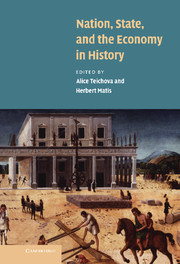Book contents
- Frontmatter
- Contents
- List of figures
- List of tables
- List of contributors
- Acknowledgements
- Introduction
- PART I
- 1 Political structures and grand strategies for the growth of the British economy, 1688–1815
- 2 Economic factors and the building of the French nation-state
- 3 Nation building in Germany: the economic dimension
- 4 The harmony liberal era, 1845–1880: the case of Norway and Sweden
- 5 Nationalism in the epoch of organised capitalism – Norway and Sweden choosing different paths
- 6 Economic development and the problems of national state formation: the case of Spain
- PART II
- PART III
- PART IV
- PART V
- Index
5 - Nationalism in the epoch of organised capitalism – Norway and Sweden choosing different paths
Published online by Cambridge University Press: 07 September 2009
- Frontmatter
- Contents
- List of figures
- List of tables
- List of contributors
- Acknowledgements
- Introduction
- PART I
- 1 Political structures and grand strategies for the growth of the British economy, 1688–1815
- 2 Economic factors and the building of the French nation-state
- 3 Nation building in Germany: the economic dimension
- 4 The harmony liberal era, 1845–1880: the case of Norway and Sweden
- 5 Nationalism in the epoch of organised capitalism – Norway and Sweden choosing different paths
- 6 Economic development and the problems of national state formation: the case of Spain
- PART II
- PART III
- PART IV
- PART V
- Index
Summary
THE DISSOLUTION OF THE UNION – NATION BUILDING OR MODERNISATION?
In 1905, the union between Norway and Sweden was dissolved. Although, formally, the two nations had been equal partners in the union, Norway had been forced into the union with Sweden in 1814. Sweden had always been the dominant state, and the joint king had always been Swedish. From the Norwegian point of view, the dissolution of the union therefore represented national liberation and independence, and the national rhetoric flourished. It is also relevant that the dissolution of the union came about as the result of a unilateral, actionistic, political move on the part of the Norwegians. The situation was tense, and the prospect of war loomed large. However, in the end, the conflict was settled peacefully, and for the most part, the traditionally good relations between Sweden and Norway were restored.
The problem is, however, that the union had not generally been regarded as negative from the Norwegian point of view. Norway had enjoyed a relatively large degree of autonomy, and the union years had been a period of growth in terms of the economy, culture and political democracy. In the latter area, Norway had come further than Sweden, whereas in terms of economic and cultural development, the two nations were pretty much on a par. Otherwise, there are many obvious parallels in the two countries' development during this period.
- Type
- Chapter
- Information
- Nation, State and the Economy in History , pp. 96 - 112Publisher: Cambridge University PressPrint publication year: 2003



